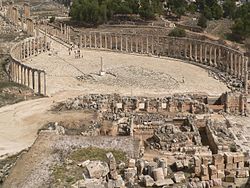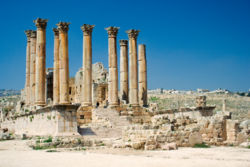Jerash

Jerash, a city in northern Jordan, is famous for its Roman ruins. The archaeological site is popular for tourists, second only to Petra.
Understand
[edit]
48 km (30 miles) north of the capital Amman, Jerash is known for the ruins of the Greco-Roman city of Gerasa, also referred to as Antioch on the Golden River. It is sometimes misleadingly referred to as the "Pompeii of the Middle East", referring to its size, extent of excavation and level of preservation (though Jerash was never buried by a volcano).
Jerash became an urban center during the 3rd century BC and a member of the federation of Greek cities known as the Decapolis ("ten cities" in Greek). Jerash prospered during the 1st century BC as a result of its position on the incense and spice trade route from the Arabian Peninsula to Syria and the Mediterranean region. Jerash was a favorite city of the Roman emperor, Hadrian, and reached its zenith in AD 130, flourishing economically and socially. The city began to decline in the 3rd century, later becoming a Christian city under the rule of the Byzantine empire. The Muslims took over in AD 635, but the final blow to the city was dealt by Baldwin II of Jerusalem in AD 1112 during the Crusades.
Modern Jerash sprawls to the east of the ruins, sharing the same city wall but little else. Thankfully, the ruins have been carefully preserved and spared from encroachment.
Get in
[edit]By car
[edit]From 8th Circle in Amman, take the north-west road out towards Salt. Eventually you must turn northward, but brown tourism signs clearly mark the road towards Jerash.
By bus
[edit]Getting to Jerash is very easy and cost effective on your own and you don't need a tour. You can go to Jerash and back for 2 JD from the Tabarbour Bus Station (North station) in Amman, or from Sweileh park. At the Tabarbour Bus Station, buses leave for Jerash – 1.00 JD, about one hour, but are not that frequent (May 2025) since the BRT is running. It is better to take them close to the Sweileh park (1.00 JD). From downtown Amman, take the BRT (Bus Rapid Transfer) at the Jordan Museum and go directly to its terminus at Sweileh BRT Station. From there, leave the station, cross the park and ask people for the serviis to Jerash.
In Jerash, the minibuses to Amman leave from a junction by the handicraft building (10-minute walk south from the visitor's centre). When coming back to downtown from Tabarbour station tell the taxi driver you are going to Raghadan Al Seyaha. There is another Raghadan station in Amman that is a few kilometers from downtown so the last stop may be that one!
By taxi
[edit]A private taxi from Amman can be hired for 8-10 JD one-way. Expect to pay as much as 40 JD for a return trip and taxi driver staying on site while you look around. As always, negotiate the amount beforehand and specify that the price is for the whole taxi and not "per person," which most taxi drivers will try to charge you.
Get around
[edit]Walking is the only choice you have – about 3 km all together. Get in at the south end of the archaeological site south of the Hippodrome. The North Gate is closed.
See
[edit]


Signs describing the history of each set of ruins have been introduced, and you can pick up a map to orient yourself at the Visitor Centre, at the South Gate of the archaeological park. You can exit at the North Gate, which is across from the bus station.
The ruins are extensive compared to many other sites, but it's not hard to see everything in a couple of hours. It is unlikely that visitors will miss anything important.
Beware of the many touts inside the area, who will try to sell you "original" coins, artifacts and antiques, after they helped you taking your picture. If they stand in the way of your picture in front of the many sights, especially the Nymphaeum and the Temple of Artemis, firmly ask them to step aside. If they do not cooperate, tell them you will complain with the visitor center.
If you go first thing in the morning, you can avoid most of the tour groups arriving from Amman.
- Jerash Ruins. Summer 07:30-19:00; winter 08:00-17:00. The Temple of Artemis and the temple right after the entrance overlooking the Oval Plaza have hidden staircases in their walls, which allow you to climb up the ruins, having a great view of the surrounding area - be careful, there is no barrier at the top to prevent you falling off the ancient buildings. 10 JD for foreign visitors (0.5 JD for locals); free with Jordan Pass.
- 1 Jerash Archaeological Museum. Features a collection of artifacts found during excavation, including coins, statuary and sarcophagi. Free.
- 2 Hadrian's Arch. Built in 129 AD to mark Emperor Hadrian's visit, this was intended to become the new southern gate of the city.
- 3 Hippodrome. A partially restored Roman-era stadium. At only 245 m long and 52 m wide, it was the smallest hippodrome in the Roman Empire. The costumed centurion will expect 1 JD for a photo.
- 4 Oval Plaza (Forum). An unusual wide, asymmetrical plaza at the beginning of the Cardo (or Colonnaded Street), built in the 1st century AD. The Oval Plaza is 80 m by 90 m (262 ft by 295 ft) and is enclosed by 160 Ionic columns.
- 5 Temple of Zeus. Above the temple there is the South Theater and another temple from which you have a great view onto the Oval Plaza.
- 6 South Theater. An amphitheatre that seats up to 3000. It is occasionally used today for concerts and musical productions. Daily features include bag pipers in traditional Jordanian military dress.
- 7 The Cardo (Maximus). A 600-m (660-yard) colonnaded street that runs the length of the city. It was once lined with the city's major buildings, shops and residences. A complex drainage system lies below the stone paving. Look for chariot tracks in the stone.
- 8 Agora. The city's main food market, which has a central fountain.
- 9 Nymphaeum. An ornate public fountain that was decorated with lions heads and dedicated to the nymphs.
- 10 Temple of Artemis. Impressive temple ruins dedicated to the patron goddess of the city.
- Sound and Light Show. There is an evening light show that illuminates the ancient sites of Jerash in different colours. 2 JD.
- Roman Army and Chariot Experience. Two daily shows, 11:30 and 14:30, at the hippodrome (circus) include Roman Legion tactics, mock gladiator fights, and chariot exhibitions. Just ask and you will be allowed to go on a chariot ride after the show. 12 JD.
Do
[edit]- [formerly dead link] Music and Arts Festival. Jerash is home to this an annual festival each summer.
- The Jordan Trail. The Jordan Trail spans the entire length of Jordan, stretching from Umm Qais in the north to Aqaba in the south, covering over 650 kilometers and passing through 52 villages and towns. This extensive hiking route offers a captivating 40-day journey through the diverse landscapes of Jordan.
Buy
[edit]Just outside of the archaeological park's South Gate is a small souq — an outdoor bazaar, of sorts — that provides a well-rounded offering of Jordanian souvenirs and handicrafts. Many of the shop keepers are amiable and are willing to bargain over prices. Local children and teens will try to sell you Roman coins and other small artefacts found on the site. Please refrain from buying from them, as this practice is not legal.
Eat
[edit]Along the road into Jerash there are several other restaurants from which to choose.
- 1 The Lebanese House (Walk past the police kiosk on the main street and turn down the dirt road), ☏ +962 26351301. Cooks up some good Lebanese food, particularly when it comes to Mezza.
Sleep
[edit]Accommodation in Jerash is sparse.
- 1 Hadrian's Gate Hotel, Jerash Main Road, opposite Hadrian's Arch, ☏ +962 77 779 3907. Inexpensive and very conveniently located across the road from the entrance to the archaeological park.
- 2 [dead link] The Olive Branch, Ajloun Road (7 km outside town), ☏ +962 2 634 0555, fax: +962 2 634 0557, [email protected]. In the hills above town. Quiet and relaxed with a nice swimming pool, but only accessible by car or taxi. Apparently also has a campground. Own tent is required. The campground has lots of resort type luxuries. 5 JD for the campground.
- 3 Dibbin National Park. Camping. A bit outside the main town, recommended to visit in the week, the weekends are pretty busy. 3 JD.
Go next
[edit]The 1 Jerash Bus Station is outside the northern end of the Jerash archaeological side. However, buses also leave from the 2 main junction in Jerash just south of the Hippodrome to Amman and Ajlun Castle.
- Ajlun & Ajlun Castle – The castle is an interesting maze of passages and levels, and offers a wonderful view of the surrounding area, northwestern Jordan, and off into Galilee. This Islamic fortress is a mere 16 km east from Jerash. The castle is located on the top of a mountain just outside the small city of Ajlun. If you start your day early enough, you can take the bus from Amman to Ajlun and see the castle. Afterwards take a bus from 'Ajloun to Jerash, while still having plenty of time to spend at Jerash. Ajlun and Jerash make a good combination day; however, most buses travel from Ajlun to Jerash and not the other direction. Therefore, it is better to travel from Amman to Aljun Castle, then to Jerash, then back to Amman. Once in Aljun, take a taxi to Aljun Castle and arrange for the taxi to wait for you or to transport you back to the Aljun bus station. In the afternoon the buses become infrequent and you run the risk of being left in one of the cities if you do not plan accordingly, especially during Ramadan. If this occurs, stand around across from the police station and you can probably bargain with a private driver to take you back to Amman.
- Irbid – The main industrial and administrative centre in the north of the kingdom, and a staging point for exploration further afield to Gadara (Umm Qais), Pella and other nearby sites within the region. 40 km north of Jerash.


 Français
Français Italiano
Italiano




